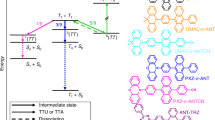Abstract
In the present paper, the results of the investigation of the decay kinetics of delayed luminescence of organic glasses are presented. A strong deviation of the decay of both phosphorescence and annihilation delayed fluorescence from the exponential law is observed. This effect is shown to be due to the relaxation process of electronic excitation energy in the system with large energetic disorder. At the same time, the presence of two time intervals in which the rate coefficient for triplet-triplet annihilation (TTA) reaction shows different dependence on time is observed. On a short time scale the classical behavior is observed, i.e., the reaction is well described by the second-order equation with a time-independent rate coefficient. At the limit of long times, we have strong dependence of rate coefficient on time, i.e., the electronic excitation energy transport is dispersive. It is shown that behavior observed for the rate coefficient for TTA reaction is due to the relaxation process (on short time scale) and the equilibrium energy migration (in long time limit).
Similar content being viewed by others
REFERENCES
R. Kopelman 1988 Science, 241, 1620.
R. Kopelman in V. M. Agranovich and R. M. (Eds.) Hochstrasser (North-Holland), Amsterdam, Spectroscopy and Excitation Dynam-ics of Condensed Molecular Systems, p. 139.
G. B. Talapatra, D. N. Rao, and P. N. Prasad (1988) J. Phys. Chem. 88, 4636.
H. Bässler, (1994) R. Richert and A. Blumen (Eds.) in Disorder Effects on Relaxational Processes, Springer-Verlag, p. 485.
E. W. Montrol and G. H. Weiss (1965) J. Math. Phys. 6, 1667.
S. Alexander and T. Orbach (1982) J. Phys. Lett. (Paris) 43, L625.
P. G. de Gennes (1983) C. R. Acad. Sci., Ser. B. 296, 881.
S. A. Bagnich and A. V. Konash (2001) Chem. Phys. 263, 101.
R. Richert and H. Bässler (1984) Philos. Mag. B 49, L25.
R. Richert and H. Bässler (1986) J. Chem. Phys. 84, 3567.
G. Schonherr, H. Bässler, and M. Silver (1981) Philos. Mag. B. 44, 47.
S. A. Bagnich (1995) Phys. Solid State 37, 555.
S. A. Bagnich (1997) Chem. Phys. 214, 351.
S. A. Bagnich (1998) Chem. Phys. 237, 359.
S. A. Bagnich and A. V. Konash (2001) J. Appl. Spectr. 68, 439.
S. A. Bagnich and A. V. Dorokhin (1993) Chem. Phys. 172, 153.
L. A. Harmon and R. Kopelman (1990) J. Phys. Chem. 94, 3454.
R. Kopelman, L. Li, S. Parus, and J. Prasad (1987) J. Luminesc. 38, 289.
R. Kopelman, S. Parus, and J. Prasad (1988) Chem. Phys. 128, 209.
J. Prasad and R. Kopelman (1989) Chem. Phys. 157, 535.
S. A. Bagnich (1998) Ceramics 57, 85.
B. Kozankiewicz (1997) J. Luminsc. 71, 37.
S. A. Bagnich (1999) Phys. Rev. B 60, 11374.
Author information
Authors and Affiliations
Corresponding author
Rights and permissions
About this article
Cite this article
Bagnich, S.A., Konash, A.V. Kinetics of Triplet-Triplet Annihilation in Organic Glasses. Journal of Fluorescence 12, 273–278 (2002). https://doi.org/10.1023/A:1016885406369
Issue Date:
DOI: https://doi.org/10.1023/A:1016885406369




